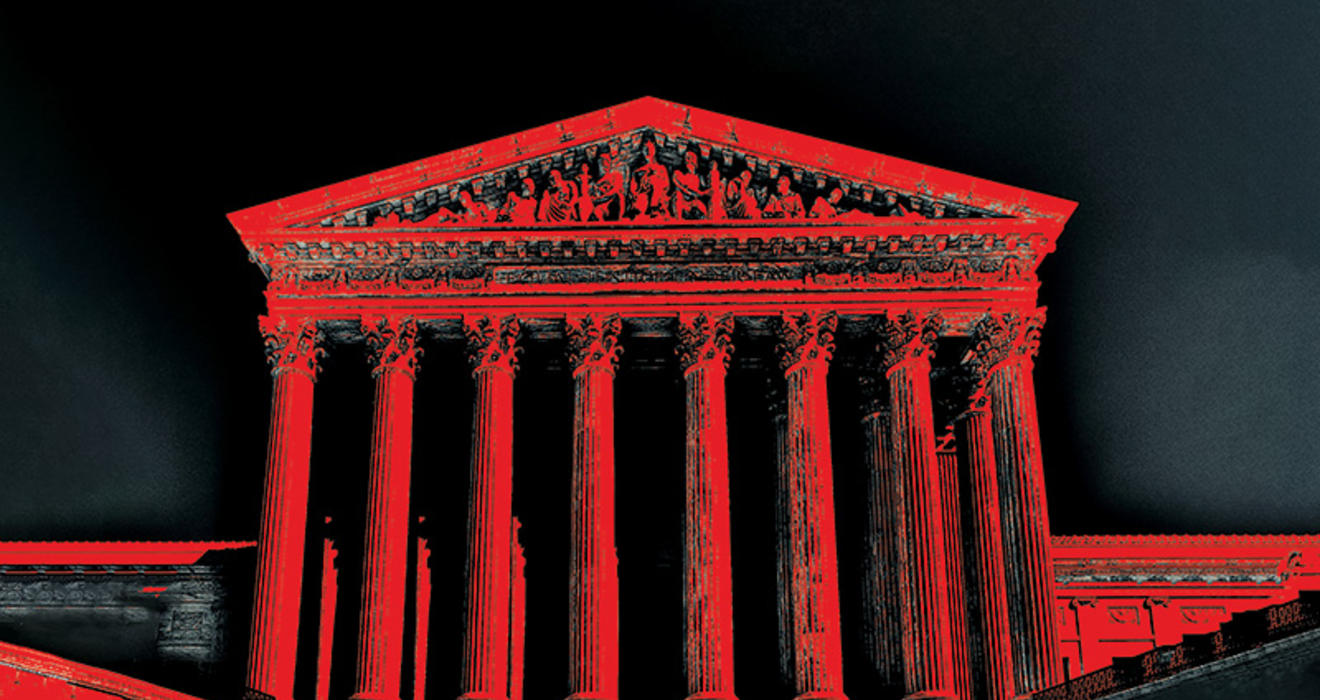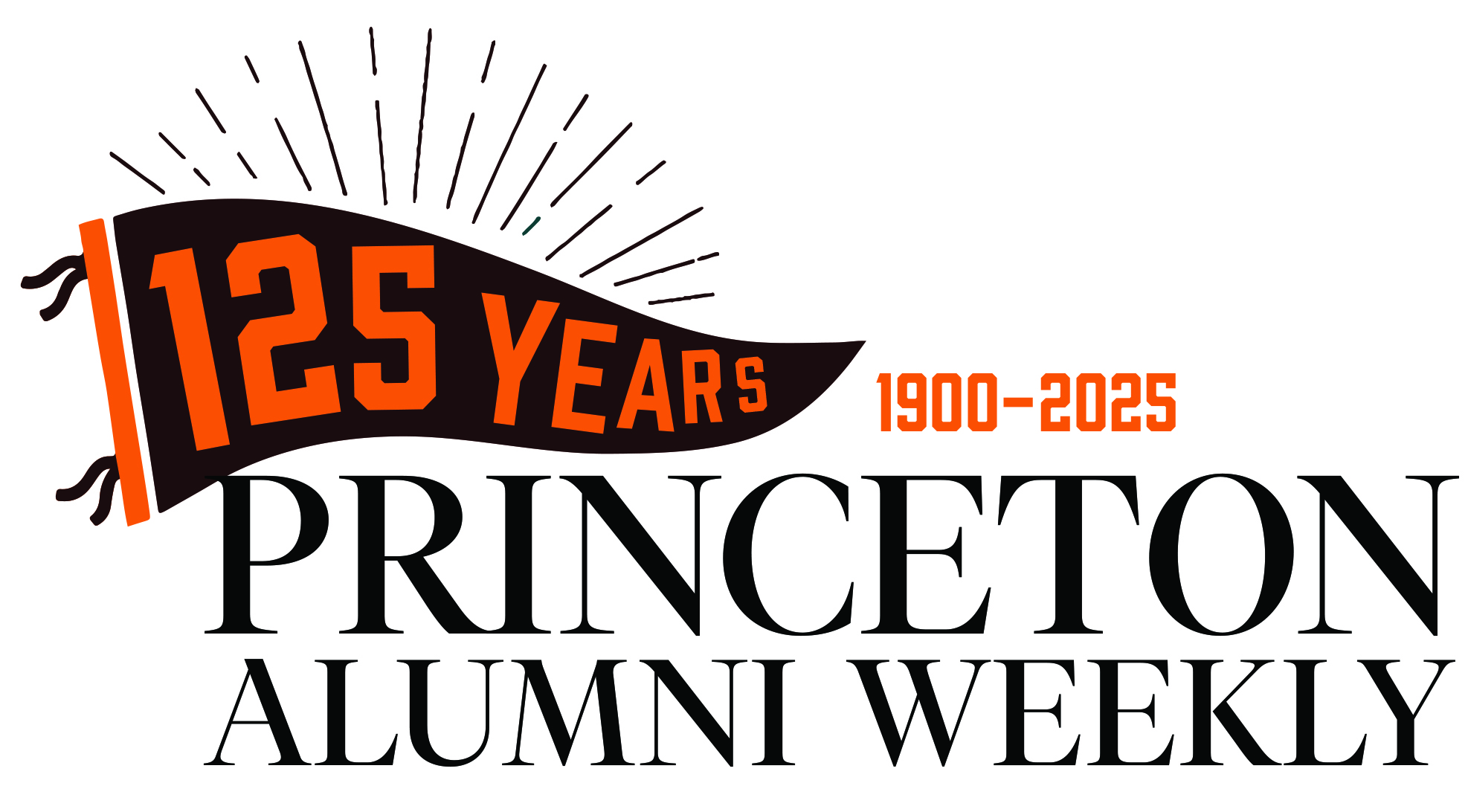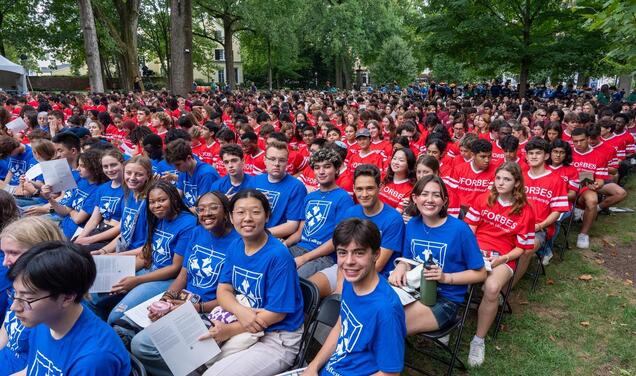
When the U.S. Supreme Court struck down the use of race in admissions as unconstitutional in June, rising sophomores Zavier Foster and Zach Gardner had very different reactions.
Writing “with a heavy heart” on behalf of the Princeton Black Men’s Association, Foster expressed dismay at the thought of “how many underprivileged Black and Brown students will be unable to gain access to elite institutions due to these backwards rulings. … We already mourn the opportunities that have been ripped from minorities across the country.”
Gardner, in an opinion column for The Princeton Tory, waxed ecstatic and caustic about President Christopher Eisgruber ’83’s calling the decision “unwelcome” and “regrettable.”
“The Constitution had a great week at the Supreme Court,” wrote Gardner, an aspiring lawyer and member of Princeton’s Federalist Society. He voiced hope “that students from all walks of life can be assured that they will be evaluated … as unique individuals who will make valuable contributions to their campus, their community, and their country.”
Even now, tens of thousands of high school seniors around the country and the world are taking SATs — optional since the pandemic — and polishing essays in hopes of walking the campus pathways with Foster and Gardner. Princeton in August tweaked the short essay questions on its application to comply with the Supreme Court ruling, including asking applicants to write about how “your lived experience has shaped you.”
That is a nod to the allowance Chief Justice John Roberts Jr. offered in the majority opinion overturning the outright use of race in admission decisions at his alma mater, Harvard, and the University of North Carolina, “[N]othing in this opinion should be construed as prohibiting universities from considering an applicant’s discussion of how race affected his or her life, be it through discrimination, inspiration, or otherwise.” But Roberts added this caveat: “[U]niversities may not simply establish through application essays or other means the regime we hold unlawful today.”
Princeton will now try to figure out how to thread that needle. In August, the Board of Trustees established an ad hoc committee to examine Princeton’s admission policies, guided by two key principles: merit-driven admissions and the imperative to attract students from all sectors of society, including underrepresented groups. It presumably will review whether to keep the boost that children of alumni get in admissions. The Class of 2027 included 13% of students who are legacies, according to the University.
Eisgruber, a constitutional scholar, declined an interview request, as did Dean of Admission Karen Richardson ’93.
PAW spoke with the Princeton-educated presidents of Northwestern University, Hamilton College, and Willamette University who are wrestling with the same dilemma of how to achieve diverse student bodies with a principal tool off the table. We also sought the views of expert faculty and alumni.
The fear among educators is that what happened at UCLA, Berkeley, and other University of California campuses after voters passed Proposition 209 in 1996, and again in Michigan when voters there banned affirmative action in 2006, will repeat itself. Enrollment of Black students plunged by more than half but subsequently has largely rebounded.
Two decades ago, when Princeton enrolled 4,635 undergraduates, the student body was 65% white, 12% Asian, 8% Black, 7% international, and 6% Hispanic. Last year, among 5,527 students, 38% were white, 24% Asian, 8% Black, 12% international, 10% Hispanic, and 7% multi-racial.
Princeton already is looking hard for talent at under-resourced schools that don’t typically send graduates to the Ivy League. The percentage of federal Pell Grant recipients, which target low-income Americans, surged from 7% for the Class of 2008 to almost 25% for the Class of 2023.
Admission to Princeton is a golden ticket for students who could not otherwise dream of attending one of the country’s top institutions.
Eddie S. Glaude Jr. *97, University professor and former chair of the Department of African American Studies, reacted with anguish to the Supreme Court decision, saying on MSNBC that he foresees a return to “a kind of segregated higher education landscape” with elite institutions enrolling predominately white and Asian students. Affirmative action was “the only remedy to the legacy of discrimination in admissions in American higher education … so here they’ve taken it away.”
“What the court has done is very bad. That there’s been such a backlash against such a modest reformist measure as racial affirmative action is quite sobering.”
— Randall Kennedy ’77
Harvard Law School professor
Robert P. George, founder and director of Princeton’s James Madison Program in Ideals and Institutions and McCormick Professor of Jurisprudence, applauded the ruling and says he does not believe it will “prevent Princeton or other colleges and universities from having diverse student bodies.” Assessing applicants as individuals, and not as members of so-called “overrepresented” or “underrepresented” groups, while considering the challenges they have faced “is likely to result in what will be in important ways a more diverse student body.
“There could be a broader mix of political, moral, religious, and cultural viewpoints than we currently have.”
Hamilton College President David Wippman ’77, a former law school dean, says he “was disappointed but not surprised” by the ruling. Hamilton is need-blind and accepted 11.8% of 9,899 applications for its Class of 2026. (Princeton’s acceptance rate for the Class of 2026 was 5.7% of 38,091 applicants.)
“Something that gets lost in a lot of discussions is people want to single out race as a single factor as having a dominant influence on the outcome of the admission decision. We really look at a large number of factors, whether that’s your SAT score, GPA, race, geographic origin, recommendations, and a host of other things,” Wippman says.
Now, under Roberts’ instructions, Wippman says Hamilton still can consider race not by itself but in an individually tailored way as opposed to a check-the-box way. “And I would say that we tried to consider it in an individual way in the past,” he adds. “Diversity will remain a priority. We just have to be very careful [how] we do it.”
Northwestern University accepted 7.2% of the 51,554 who applied last year. Its president, Michael Schill ’80, also a former law school dean, was “surprised and disappointed by the way the majority opinion devalued diversity as an objective.” Roberts wrote that Harvard’s claim it was training future leaders and providing a better education through diversity cited commendable goals but not coherent or measurable enough to warrant use of racial preferences.
Schill says he wished the court had treated the diversity issue “in a more serious way rather than just saying it’s sort of vague and subjective.”
The vast majority of the country’s 2,600 four-year colleges and universities admit a majority of students who apply, including private Willamette University, in Salem, Oregon, with 1,585 undergraduate students. Its president, astrophysicist Stephen Thorsett *91, spent five years on Princeton’s faculty in the 1990s and taught at the University of California, Santa Cruz before taking on the Willamette presidency in 2011. It admitted 79% of the 4,107 students who applied this year.
Only its law school made limited use of affirmative action, Thorsett says, but the high court ruling has impacted Willamette.
“It has led us to review other programs that included the use of race as usually one among a number of criteria, for example, in early college outreach programs,” he says, as well as endowments that have restrictions based on race or national origin. “We’ve been talking with donors and at times with the courts to revise those to bring them into alignment with what we knew was coming.”
In a state where 87% of the residents are white, “we’re about a third students of color,” Thorsett says.
“The thing that I worry about perhaps most is signaling to populations of students that have been historically underrepresented or excluded that in some way we don’t see them as important,” he says. “If there are voices in society making the argument that this isn’t important anymore, we have to be really strong in making that argument that institutions [such as Willamette] are for them.”

Princeton alumni voiced a diversity of opinions about the Supreme Court’s ban on affirmative action.
Mitch Daniels ’71, who recently completed a 10-year run as president of Purdue University, says, “I think everybody, by one means or another, has tried to find ways to recruit students who can diversify their student body, some by benign means and some by means that were very unfair.
“I don’t think the court could have come to any other conclusion. The discrimination was overt, obvious, and at a significant scale,” the former Indiana governor says. “It was hard to justify much of what was going on as consistent with [the 14th Amendment’s] equal protection.”
As a land grant school, Purdue is “deeply imbued with the mission of expanding access,” says Daniels, who froze tuition for a decade and expanded the student body by 30%. “We took all kinds of steps to recruit [minority] students aggressively,” he says, including launching three Purdue charter high schools in Indianapolis and South Bend emphasizing technology.
Harvard Law School professor Randall Kennedy ’77 and legal journalist Stuart Taylor Jr. ’70 are friends of long standing, but on opposite ends of debates over affirmative action. Kennedy made the argument for it in his 2013 book, For Discrimination: Race, Affirmative Action, and the Law. A year earlier, Taylor co-authored Mismatch: How Affirmative Action Hurts Students It’s Intended to Help, and Why Universities Won’t Admit It.
In a recent analysis of the Harvard-UNC decision in the London Review of Books, Kennedy wrote, “Racial affirmative action does have major drawbacks. For one thing, it puts a pall over the racial minorities assumed to be its beneficiaries.” But he argues that its scope was modest and its aims were commendable, even if they came at “steep costs” and adversely affected some white applicants with higher test scores and grades.
“Its termination at the hands of a reactionary Supreme Court is a significant setback,” Kennedy wrote. “Racial hierarchy in the U.S. remains a huge problem. The Supreme Court’s suppression of affirmative action calls into sharp question whether America has within it the moral and political resources to address satisfactorily that long-festering injustice.”
“What the court has done is very bad,” Kennedy tells PAW. “That there’s been such a backlash against such a modest reformist measure as racial affirmative action is quite sobering.”
Taylor, co-founder of Princetonians for Free Speech, which advocates for academic freedom and “viewpoint diversity” on campus, says affirmative action penalized Asian Americans as well as white students. He says he believes that Black students who benefited most “tend to be the children of recent immigrants and children of upper-class Black people, not descendants of slaves. Obviously, some are, [but] it’s very divisive.”
Taylor says it “would be terrible” if the number of Black students admitted to Princeton dropped by half — which is what Harvard predicted would happen to it — but doubts that will occur. He foresees more lawsuits ahead as universities seek to evade the ruling in “any way they can.”
“I don’t think the court could have come to any other conclusion. The discrimination was overt, obvious, and at a significant scale.”
— Mitch Daniels ’71
former president of Purdue University
Zavier Foster came back to school early to work at freshman orientation. “I’m seeing all the freshman people of color move in and it’s kind of sad because you just know that next year there’s going to be so many less,” he says.
Foster is from Baldwin, New York, the son of Jamaican immigrants. He chose Princeton from among 19 schools to which he won admission. He says he does not feel he benefited from affirmative action. If his grades, SAT scores, essays, and activities were put up against those of white classmates, “I think they would match or outshine them.”
“I can’t speak for every individual Black student about how they feel about their position here at Princeton, but I will say from the conversations I’ve had that no one thinks it’s a stigma at all. We’re all at the same place and all doing the same things,” says Foster, a politics major who envisions going to law school or business school.
Zach Gardner, the son of a pastor and a Chick-fil-A executive from Atlanta, is also a politics major who has gotten a head start on his planned career as a lawyer by interning twice for a federal appellate judge. He applied early and chose Princeton over the University of Virginia and the University of Georgia.
He says he feels right at home on a campus where political conservatives are a distinct minority among students and the faculty.
“Princeton is a wonderful place to be, especially for conservatives, because we have such an incredible group of people on campus and professors and institutions that are very welcoming to different viewpoints,” says Gardner. “Everyone that I’ve met at Princeton, whatever the race, religion, ethnicity, beliefs, ideologies, they all come across to me as perfectly qualified to be here.”
Gardner doubts there will be a big drop in the Black student population. “If it does, I think that’s a conversation to be had when the time comes,” he says. Regardless, “It wouldn’t change the legal reality that the admissions department simply cannot use race qua race as a factor in admissions.”
Christopher Connell ’71 is a freelance writer based in Washington, D.C.






2 Responses
Peter J. Greenhill ’81
1 Year AgoA Poor Decision, Poorly Supported
The words of Princeton student Zach Garner ’26 and Professor Robert P. George in Christopher Connell ’71’s article entitled “Affirmative Reaction” in the October issue are reason for concern. When Professor George maintains that even though affirmative action now has been discontinued he does “not believe [ending affirmative action] will ‘prevent Princeton or other colleges from having diverse student bodies,’” he is guilty of the same self-deception Mr. Garner is guilty of when the latter says that ending affirmative action means that “students from all walks of life can be assured that they will be evaluated … as unique individuals.” Until affirmative action came along, that was not even close to being true, which was a big reason the policy was developed and implemented in the first place. When we see how much racism still permeates our society and its institutions, there simply is no reason to be confident that what both men assert so blithely will become the case in the days and years ahead. That “students from all walks of life” are treated “as unique individuals” wasn’t true before affirmative action, and there is little reason to think that it will be now that we again do not have a law like it.
It seems that Professor George not only ignores the data on the demographics of students who have benefited from affirmative action (see his assertion that “children of upper-class Black people” were among the groups that benefited the most), he goes further by being Orwellian to the extreme when he says, that without affirmative action, “There could be a broader mix of political, moral, religious, and cultural viewpoints than we currently have.” Really? Take a policy meant to address inequities, watch it succeed in doing so for an extended period, then remove it and claim we will get the same results? I suppose he’s correct if his words mean a mix of views and appearances that are all still similar to his and Mr. Garner’s. His unsupported pronouncement collapses even if all one does is glance at the article’s bar graph, “Changes in Princeton’s undergraduate population since 2002-03,” which shows rather clearly the beneficial effects of affirmative action (even if the graph alone does not prove causation, it shows a very powerful correlation). It is extremely naïve and myopic to think that these changes at Princeton took place under 20 years of affirmative action and yet affirmative action played no part in them. Affirmative action has mattered in a positive way, and I imagine that it is heartening to anyone that this is so, except perhaps to those who shed tears for privileged white children in the admissions process who may have, for the first time in their lives, not gotten exactly what they wanted. Please forgive me if I am among those who do not weep for them.
The kind of Orwellian speciousness that appears in the remarks these two men made in the article — as opposed to the persuasive words of professors Eddie S. Glaude, Jr. *97 and Randall Kennedy ’77 — should be beneath a Princeton student (though we must compassionately remember that students are still learning) but even more beneath a Princeton professor. It is very demoralizing to see wording like theirs that seems designed stealthily to assure that Princeton’s student body in the future looks as much like the two of them as possible. In the process, it becomes a perfect example of what economist John Kenneth Galbraith meant when he described such sophistry as engaging “in one of man’s oldest exercises in moral philosophy; that is, the search for a superior moral justification for selfishness.”
Robert P. George, McCormick Professor of Jurisprudence
1 Year AgoFull Quotations
Christopher Connell interviewed me for his story, and some quotations from me appear in it, but (quite reasonably) he was unable to include everything I said. I’m therefore reproducing here his questions and my complete answers:
What do you think will be the impact of the Supreme Court’s ruling against explicit use of race in admissions decisions on the composition of Princeton’s student body and those at other highly selective U.S. colleges and universities? Will that be for good or ill?
I suspect that Princeton and other universities will revise their practices to comply with the Supreme Court’s ruling that an applicant’s race or ethnicity, as such, may not be counted for or against him or her. These institutions will, however, continue to seek to admit classes in which students come from a wide variety of backgrounds and bring a diversity of experiences. I expect that Princeton will redouble its efforts to admit more students from less affluent backgrounds, especially those who have attained high levels of academic and other forms of achievement despite their comparatively modest family circumstances. The Supreme Court’s rulings in the Harvard and University of North Carolina cases forbid giving preferences to applicants based on race or ethnicity, but do not forbid preferences based on, for example, socio-economic class. To the extent that these rulings push universities to assess applicants as individuals, and not treat them as members of groups (be they so-called “overrepresented” or “underrepresented” groups), I think they are for the good. They won’t prevent Princeton or other colleges and universities from having diverse student bodies.
Virtually all colleges embrace efforts to increase the diversity of their students, faculty and staff. Do you think that this ruling will undercut that? Do you foresee a Princeton that is less racially and ethnically diverse?
As I said, I do not expect the rulings in the Harvard and University of North Carolina cases to result in a less diverse student body. Indeed, more individualized assessments of candidates, especially taking into account the challenges they have faced (which could be the result of social class, race or ethnicity, disability, religion, or a range of other factors), is likely to result in what will be in important ways a more diverse student body. Among the respects in which the student body might be more diverse, is that there could be a broader mix of political, moral, religious, and cultural viewpoints than we currently have. You note that colleges are seeking more diversity of faculty as well as students. The Supreme Court decisions, though the cases directly concerned the admission of students, by their logic do apply to faculty and staff hiring. An area in which Princeton, like most other prominent private and public universities, needs improvement is the area of faculty viewpoint diversity. This was stressed by Dr. Cecilia Rouse, writing in the Princeton Alumni Weekly, when she was Dean of the Woodrow Wilson School. I hope it will be very much in our minds as we move forward in light of the Supreme Court’s rulings.
Should Princeton keep giving legacy applicants an advantage? Last year, 12.5 percent of undergraduates were legacy admits [presumably mostly with strong academic credentials, not marginal ones].
The Supreme Court’s rulings do not forbid giving legacy applicants an advantage. My sense, however, is that the days of giving the children or grandchildren of alumni a leg up in admissions are numbered. Although it is not hard in the abstract to make the case for giving a small advantage to “legacies” in the admissions process, it’s harder to make the case in the concrete historical circumstances we have here, given the fact that Princeton (like virtually all of what the University regards as its “peer” institutions) has in its record certain forms of invidious discrimination (not only against racial minorities, but also against Jews, Catholics, and others). Will abandoning the legacy preference make a big difference? I doubt it. Princeton alumni are deeply devoted to their alma mater, and strongly encourage their children to aspire to attend Princeton and make it their first choice. Many, many alumni children are super high achievers and are going to do extremely well in the admissions process, even without a legacy preference. Most alumni children who are admitted will elect to attend. Frankly, I doubt that the legacy preference makes much of a concrete difference these days in admissions decisions; so its abolition, which I suspect is coming, will not dramatically alter the make-up of the student body. We’ll still have plenty of alumni children with strong family ties to Princeton.
Princeton today admits twice as many Pell Grant-eligible students (~20 percent) as it did 15 years ago. Is enrolling more students from lower-income families sufficient to maintain the current enrollment levels of students from underrepresented racial and ethnic groups?
I don’t think or speak in terms of “overrepresented” and “underrepresented” groups. Our students are not here to represent groups. Sometimes I’ll hear people say that Jews, for example, or Asians are “overrepresented” at Princeton. I find that kind of talk deeply troubling. There’s simply no such thing as “too many Jews” or “too many Asians.” Yet it really isn’t possible to embrace the concept of “underrepresented” groups without validating the idea that some “groups” are “overrepresented.” Our policy should, therefore, be one that eschews this way of thinking. High achieving students come in all colors and from every ethnicity. We need to find them, encourage them to apply, assess them on an individualized basis (taking into account the challenges they’ve faced), select among them in a strictly non-discriminatory way, and do everything we can to encourage those we admit to enroll.